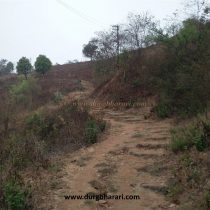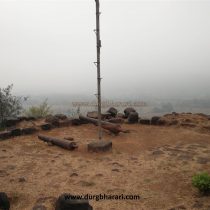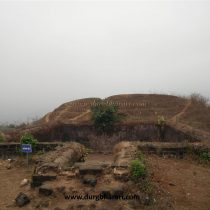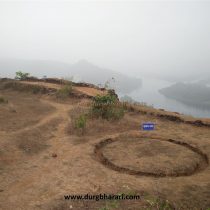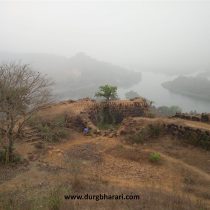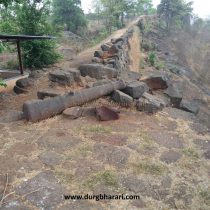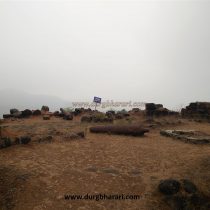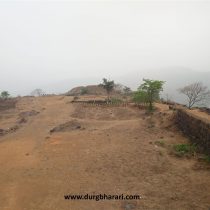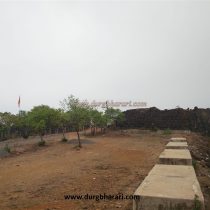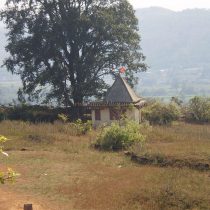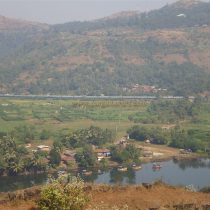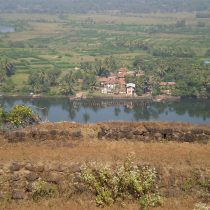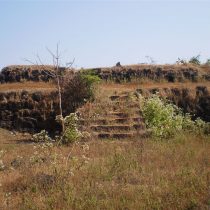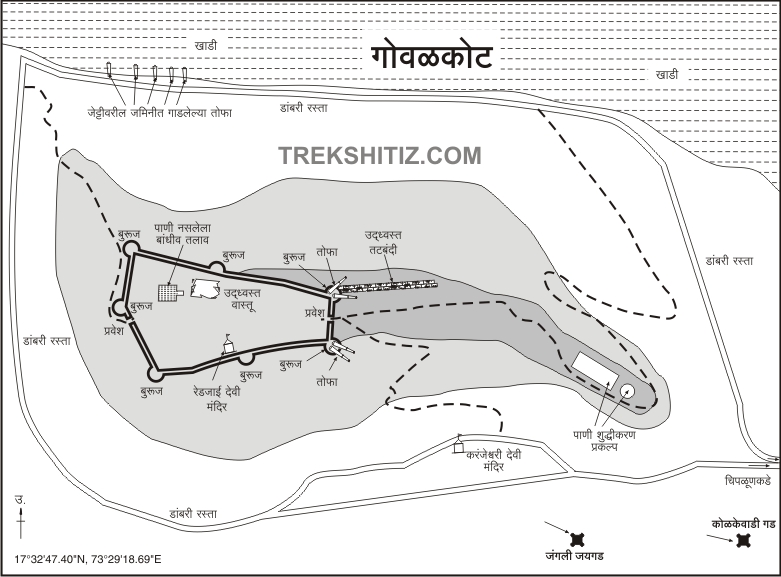GOWALKOT
TYPE : COASTAL FORT
DISTRICT : RATNAGIRI
HEIGHT : 270 FEET
GRADE : EASY
The city of Chiplun in Ratnagiri district is connected to various other cities in Maharashtra by the Konkan Railway and the Mumbai-Goa Highway. In ancient times, traders used to pass through the Vashishti river which flows through the city of Chiplun. Anjanvel aka Gopalgad fort was built at the mouth of the creek and Govindgad aka Govalkot fort was built inside the creek to control this trade route. Govalkot fort still stands on a 160 feet high hill on the banks of the Vashishti river in Chiplun city. The fort has got its natural protection as the river Vashishti that flows on all four sides of the fort. There is a beautiful temple of Goddess Karanjeshwari at the foot of this fort at a distance of 4 km from Chiplun city. If you want to stay at the fort, you must stay in this temple.
...
There is a paved road to reach the fort from this temple and in 15 minutes we reach the ruined east-facing gate of the fort built between two bastions. The hill extending east-west of the fort is divided into two parts, Machi and the citadel. On the part of the Machi of the fort, there is a water purification center that provides water to the entire Chiplun city. The door through which we enter the fort is built to go from the Machi to the citadel. Upon entering the fort through this gate, one can see four cannons on the right bastion and two on the left bastion. The rampart of the citadel is about 8 feet wide and is still in pretty good condition. There are a total of 12 bastions in this rampart and 6 of them are still in good condition. Stairs have been built in various places to reach the ramparts. Starting the fort round from the left side, we reach the recently renovated Redjai Devi temple near the bank. Another cannon can be seen on the bastion which is a little further from this temple. There is a pond in the temple premises and the locals say that the idols in this temple are ancient. If you want to stay on the fort, you can stay in this temple but there is no water facility here. Walking along the ramparts on the western side of the fort, one can see the quadrangle structures of many houses inside the fort. From the western ramparts of the fort, there is a beautiful view of the river Vashishti, its boats, green fields, and the Konkan Railway passing through it, as well as the Parashuram mountain, spread out behind it is very scenic. On the western ramparts of the fort is another ruined north-facing gate of the fort. This is the main gate of the fort facing the creek. Although its arch has collapsed, the two adjoining bastions and stone pillars indicate that there is a gate. Govalkot Jetty can be reached by descending through this gate. On the right-hand side, you will see a large 50x45 feet wide water cistern. The entire cistern is plastered with limestone and steps are built to descend into it. This cistern is always dry except in the rainy season. There is a mound of soil 10-12 feet high at the back of the cistern and there should be a big mansion in this place. The entire fort is visible from this hill. This area of the citadel is more than 3 acres. To the right of the cistern are six cannons lined up on a quadrangle structure. These cannons were partially buried at the base of the fort at Govalkot port for the last 200 years. These cannons were brought to the fort in 2016 in collaboration with Shri Devi Karanjeshwari Devasthan Trust and Raje Samajik Pratishthan. There is limestone on the left side of the cistern but its wheel is not in place. In the next part, there is a large quadrangle structure of the administrative office of the fort or a mansion. After seeing this structure, you come straight to the place where you enter the fort. On the way out of here, do not go down the steps but go to the Chiplun Water Treatment Plant in front. On the left side of this road, you can see the ramparts of the fort. After crossing the water purification center, you can see the bastion which is still in good condition at the end. A lot of trees and bushes are growing on this bastion. This is where your fort round ends. One hour is enough to see the whole fort. It is not known exactly who built Govindgad or Govalkot but this fort is believed to have been built by Siddi during the Adilshahi period. Around 1660, Shivaji Maharaj conquered the forts of Anjanvel and Govalkot and renamed them Gopalgad and Govindgad respectively. After the death of Sambhaji Maharaj, in 1689, Govalkot came under the control of Siddi. In 1733, Pantpratinidhi tried to take this fort from Siddi but he did not succeed. On March 20, 1736, Sardar Pilaji Jadhav and Sardar Bakaji Mahadik of Tulaji Angre under the leadership of Chimaji Appa attacked Govalkot. The Marathas fired cannons from the hill of Kalusta, west of Govalkot, but the cannonballs did not reach the fort, so long-range cannons were ordered from Bankot. In this battle, Siddi Saat and his 1300 soldiers were killed while 800 Marathas died. At this time, in the treaty, Siddi kept Govalkot under his control. After 1745, Tulaji Angre defeated Siddi and took possession of the fort. Finally, in 1818, the fort was conquered by the East India Company from the Peshwas. It is mentioned in English documents that there were 21 cannons on the fort in 1862.
© Suresh Nimbalkar

